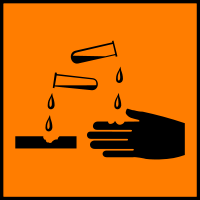

NAMES AND DATABASE IDS
NAMES AND DATABASE IDS
Names Database IDs
|
IUPAC name
|
|
3-[bis(2-carboxyethyl)phosphanyl]propanoic acid hydrochloride
|
|
|
|
|
IUPAC Traditional name
|
|
tris(2-carboxyethyl)phosphine hydrochloride
|
|
|
|
|
Synonyms
|
|
TCEP
|
|
Tris(2-carboxyethyl)phosphine hydrochloride
|
|
3,3',3''-Phosphinidynetrispropanoic Acid Hydrochloride
|
|
Tris(2-carboxyethyl)phosphine Hydrochloride
|
|
Tris(carboxyethyl)phosphine Hydrochloride
|
|
TCEP Hydrochloride
|
|
Tris(2-carboxyethyl)phosphine hydrochloride solution
|
|
三(2-羧乙基)膦 盐酸盐
|
|
三(2-甲酰乙基)膦盐酸盐
|
|
三(2-羧乙基)膦 盐酸盐 溶液
|
|
|
|
|
CAS Number
|
|
|
MDL Number
|
|
|
Beilstein Number
|
|
|
Merck Index
|
|
|
PubChem SID
|
|
|
PubChem CID
|
|
DATA SOURCES
DATA SOURCES
All Sources Commercial Sources Non-commercial Sources
CALCULATED PROPERTIES
CALCULATED PROPERTIES
JChem
|
Acid pKa
|
3.2212362
|
H Acceptors
|
6
|
H Donor
|
3
|
LogD (pH = 5.5)
|
-6.017164
|
LogD (pH = 7.4)
|
-10.102781
|
Log P
|
-1.2397103
|
Molar Refractivity
|
59.157 cm3
|
Polarizability
|
21.855902 Å3
|
Polar Surface Area
|
111.9 Å2
|
Rotatable Bonds
|
9
|
Lipinski's Rule of Five
|
true
|
PROPERTIES
PROPERTIES
Physical Property
Safety Information
Product Information
Bioassay(PubChem)
|
Solubility
|
|
H2O: soluble1 M, clear, colorless (no residue)
|
 Show
data source Show
data source
|
|
H2O: soluble50 mg/mL
|
 Show
data source Show
data source
|
|
Methanol
|
 Show
data source Show
data source
|
|
Soluble in water
|
 Show
data source Show
data source
|
|
Water
|
 Show
data source Show
data source
|
|
|
Apperance
|
|
Crystalline powder
|
 Show
data source Show
data source
|
|
white powder
|
 Show
data source Show
data source
|
|
White Solid
|
 Show
data source Show
data source
|
|
|
Melting Point
|
|
169-172°C
|
 Show
data source Show
data source
|
|
177-178°C
|
 Show
data source Show
data source
|
|
|
Density
|
|
1.041 g/mL at 25 °C
|
 Show
data source Show
data source
|
|
|
Refractive Index
|
|
n20/D 1.367
|
 Show
data source Show
data source
|
|
|
Absorption Wavelength
|
|
λ: 260 nm Amax: 0.05
|
 Show
data source Show
data source
|
|
λ: 280 nm Amax: 0.03
|
 Show
data source Show
data source
|
|
|
pH
|
|
1.2-1.5
|
 Show
data source Show
data source
|
|
7.0
|
 Show
data source Show
data source
|
|
|
Storage Condition
|
|
-20°C Freezer, Under Inert Atmosphere
|
 Show
data source Show
data source
|
|
|
Storage Warning
|
|
Moisture Sensitive
|
 Show
data source Show
data source
|
|
|
European Hazard Symbols
|
 Corrosive (C) Corrosive (C)
|
 Show
data source Show
data source
|
 Irritant (Xi) Irritant (Xi)
|
 Show
data source Show
data source
|
|
|
UN Number
|
|
3261
|
 Show
data source Show
data source
|
|
UN3261
|
 Show
data source Show
data source
|
|
|
MSDS Link
|
|
|
German water hazard class
|
|
2
|
 Show
data source Show
data source
|
|
|
Hazard Class
|
|
8
|
 Show
data source Show
data source
|
|
|
Packing Group
|
|
2
|
 Show
data source Show
data source
|
|
II
|
 Show
data source Show
data source
|
|
|
Risk Statements
|
|
34
|
 Show
data source Show
data source
|
|
36
|
 Show
data source Show
data source
|
|
|
Safety Statements
|
|
26
|
 Show
data source Show
data source
|
|
26-27-36/37/39
|
 Show
data source Show
data source
|
|
26-36/37/39-45
|
 Show
data source Show
data source
|
|
|
TSCA Listed
|
|
否
|
 Show
data source Show
data source
|
|
|
GHS Pictograms
|

|
 Show
data source Show
data source
|

|
 Show
data source Show
data source
|
|
|
GHS Signal Word
|
|
Danger
|
 Show
data source Show
data source
|
|
Warning
|
 Show
data source Show
data source
|
|
|
GHS Hazard statements
|
|
H314
|
 Show
data source Show
data source
|
|
H314-H318
|
 Show
data source Show
data source
|
|
H315-H319
|
 Show
data source Show
data source
|
|
|
GHS Precautionary statements
|
|
P280-P305 + P351 + P338-P310
|
 Show
data source Show
data source
|
|
P280-P305+P351+P338-P308+P313
|
 Show
data source Show
data source
|
|
P305 + P351 + P338
|
 Show
data source Show
data source
|
|
|
Personal Protective Equipment
|
|
Eyeshields, Faceshields, full-face particle respirator type N100 (US), Gloves, respirator cartridge type N100 (US), type P1 (EN143) respirator filter, type P3 (EN 143) respirator cartridges
|
 Show
data source Show
data source
|
|
Faceshields, full-face respirator (US), Gloves, Goggles, multi-purpose combination respirator cartridge (US), type ABEK (EN14387) respirator filter
|
 Show
data source Show
data source
|
|
|
RID/ADR
|
|
UN 3261 8/PG 2
|
 Show
data source Show
data source
|
|
|
Storage Temperature
|
|
2-8°C
|
 Show
data source Show
data source
|
|
|
Purity
|
|
≥98%
|
 Show
data source Show
data source
|
|
≥98% (NMR)
|
 Show
data source Show
data source
|
|
≥98.0% (C)
|
 Show
data source Show
data source
|
|
98%
|
 Show
data source Show
data source
|
|
|
Concentration
|
|
0.5 M
|
 Show
data source Show
data source
|
|
|
Grade
|
|
purum
|
 Show
data source Show
data source
|
|
|
Certificate of Analysis
|
|
|
Impurities
|
|
≤0.5% water
|
 Show
data source Show
data source
|
|
|
Cation Traces
|
|
Al: ≤5 mg/kg
|
 Show
data source Show
data source
|
|
As: ≤0.05 mg/kg
|
 Show
data source Show
data source
|
|
Ba: ≤5 mg/kg
|
 Show
data source Show
data source
|
|
Bi: ≤5 mg/kg
|
 Show
data source Show
data source
|
|
Ca: ≤10 mg/kg
|
 Show
data source Show
data source
|
|
Cd: ≤5 mg/kg
|
 Show
data source Show
data source
|
|
Co: ≤5 mg/kg
|
 Show
data source Show
data source
|
|
Cr: ≤5 mg/kg
|
 Show
data source Show
data source
|
|
Cu: ≤5 mg/kg
|
 Show
data source Show
data source
|
|
Fe: ≤5 mg/kg
|
 Show
data source Show
data source
|
|
K: ≤50 mg/kg
|
 Show
data source Show
data source
|
|
Li: ≤5 mg/kg
|
 Show
data source Show
data source
|
|
Mg: ≤5 mg/kg
|
 Show
data source Show
data source
|
|
Mn: ≤5 mg/kg
|
 Show
data source Show
data source
|
|
Mo: ≤5 mg/kg
|
 Show
data source Show
data source
|
|
Na: ≤50 mg/kg
|
 Show
data source Show
data source
|
|
Ni: ≤5 mg/kg
|
 Show
data source Show
data source
|
|
Pb: ≤5 mg/kg
|
 Show
data source Show
data source
|
|
Sr: ≤5 mg/kg
|
 Show
data source Show
data source
|
|
Zn: ≤5 mg/kg
|
 Show
data source Show
data source
|
|
|
Antion Traces
|
|
sulfate (SO42-): ≤50 mg/kg
|
 Show
data source Show
data source
|
|
|
Loss on Drying
|
|
≤1.0% loss on drying
|
 Show
data source Show
data source
|
|
|
λ
|
|
0.1 M in H2O
|
 Show
data source Show
data source
|
|
|
Product Line
|
|
BioUltra
|
 Show
data source Show
data source
|
|
|
Empirical Formula (Hill Notation)
|
|
C9H15O6P · HCl
|
 Show
data source Show
data source
|
|
DETAILS
DETAILS
 Sigma Aldrich
Sigma Aldrich
 TRC
TRC
Sigma Aldrich -
646547

|
Packaging
1, 10×1 mL in ampule
Application
TCEP is an effective reducing agent for protein analysis. As a non-mercaptan reducing agent, it avoids the toxicity inherent in thiol-containing compounds. It is capable of disrupting the botulinum neurotoxin B heavy-chain/light-chain complex that is held together by a single disulfide bond, and that is responsible for endocytosis, and ultimately the toxicity, of the toxin. Since disulfide-coupled subunits are characteristic of many toxins (e.g., ricin, snake venom, and all BoNT serotypes), it may be useful as a rescue prophylactic in cases of toxin administration.1 |
Sigma Aldrich -
75259

|
Application
Water soluble reagent, used for selective reduction of disulfides.1 More stable than DTT and useful in mass spectrometry applications. |
Sigma Aldrich -
C4706

|
Frequently Asked Questions
Live Chat and Frequently Asked Questions are available for this Product.
Application
Reagent for the selective reduction of disulfides in water.1
Water soluble reagent, used for selective reduction of disulfides. More stable than DTT and useful in mass spectrometry applications.
When basified, this water-soluble ligand allows for simple removal of ruthenium-derived metathesis catalysts via aqueous washing of a crude reaction mixture.
Packaging
2, 10 g in glass bottle |
Sigma Aldrich -
93284

|
Application
Water soluble reagent, used for selective reduction of disulfides.1 More stable than DTT and useful in mass spectrometry applications. |
REFERENCES
REFERENCES
From Suppliers
 Google Scholar
Google Scholar

 PubMed
PubMed

 Google Books
Google Books

- • Neuburger, M., et al.: Eur. J. Biochem., 267, 2882 (2000)
- • Krijt, J., et al.: Clin. Chem., 47, 1821 (2000)
- • Yen, T.-Y., et al.: J. Mass Spectrom., 37, 15 (2000)
- Searching...Please wait...
PATENTS
PATENTS
 PubChem Patent
PubChem Patent
 Google Patent
Google Patent
